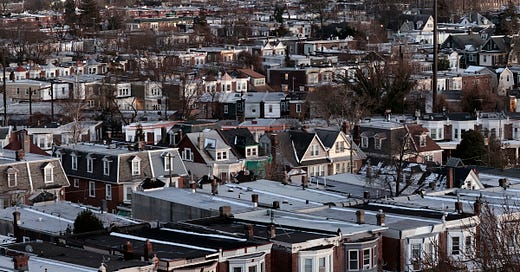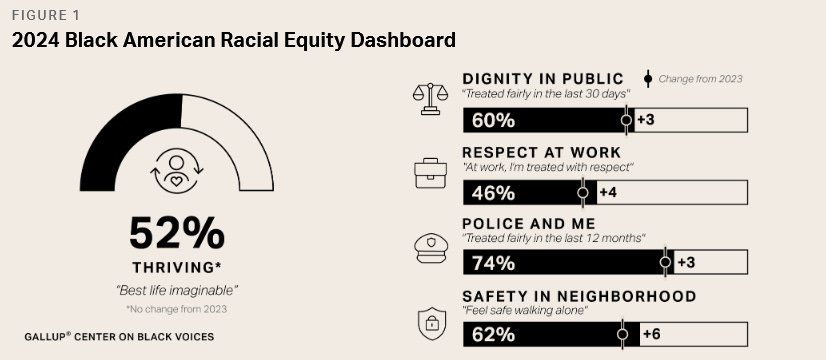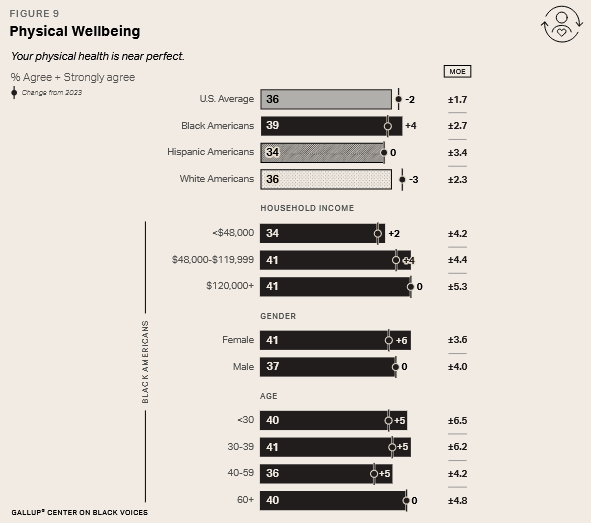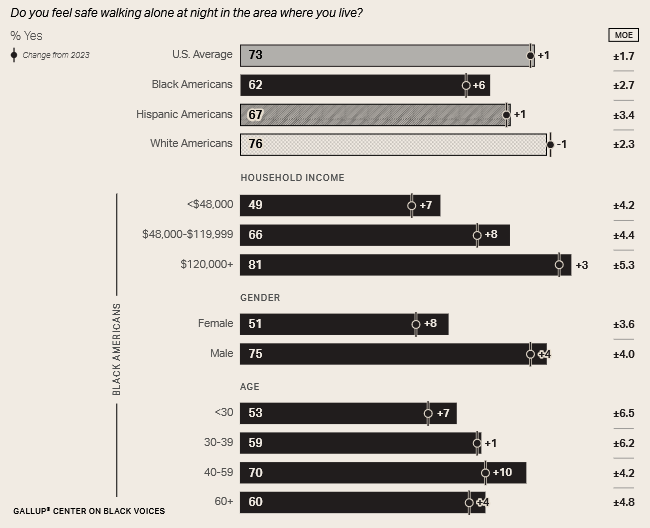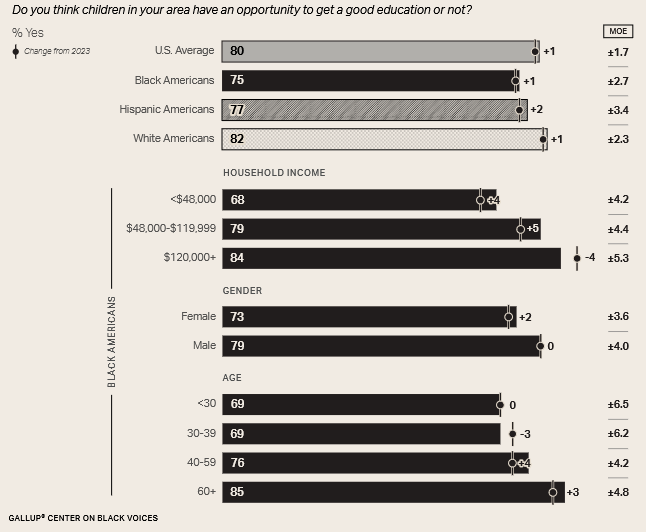a Payne Center TMCF feature
The Dr. N. Joyce Payne Research Center, in partnership with Gallup’s Center for Black Voices, released the Black Thriving in America: 2024 report this past Fall, offering a comprehensive analysis of Black Americans’ self-reported life satisfaction and well-being. This data is essential to review as we head into both a new year and a new administration that presents great uncertainties and a sense of overall anxiety for Black people.
Leveraging over 80 years of Gallup’s extensive survey data on education, employment and economic conditions, this report provided critical insights into racial equity and social justice. For the first time, it included year-over-year trended data, revealing how Black Americans truly perceive and experience social justice in their daily lives. It’s still very relevant to the conversation on community conditions and future community goals.
The 2024 report was built on the previous year’s introduction of Gallup’s “Net Thriving” metric, which categorizes life experiences into suffering, struggling and thriving. While the 2023 report highlighted similar thriving rates among Black and White Americans, it also indicated that these figures concealed significant differences based on racial identity, wealth and other factors. Last year’s findings continue to show progress — and disparity. Notable improvements include a rise in Black Americans reporting near-perfect health (39 percent) and increased career satisfaction (56 percent). There is also a positive shift in neighborhood safety perceptions.
However, the report also underscores persistent disparities. Economic wellbeing remains a concern, with only 30 percent of Black Americans feeling financially secure, compared to 40 percent of White Americans. Gaps in educational opportunities and safety perceptions are influenced by income, gender and geographic location.
Additionally, one in five Black Americans reports experiencing discrimination, particularly in interactions with police.
Last year’s Black American Racial Equity Dashboard also represented a pivotal milestone, both celebrating the progress achieved and underscoring the urgent need to address persistent disparities. As the definitive “Dow Jones of Racial Equity” and the “NASDAQ of Black American Experiences,” this dashboard provided an invaluable annual snapshot of social justice trends through rigorous empirical analysis.
Black American Racial Equity Dashboard
The 2024 Black American Racial Equity Dashboard highlights key measurements detailed in this report. The percentage of Black Americans thriving represents the percentage of Black Americans who have positive views about both their current and future lives.
A narrow majority of Black Americans (52 percent) are thriving in their wellbeing, marginally higher than the 50 percent thriving among White Americans and 48 percent among Hispanic Americans. But this rate must be considered in the context of other Black life experiences …
Dignity in Public
At least one in five Black Americans report having been treated unfairly because of their race or ethnicity while shopping (23 percent), at work (22 percent), dining out (22 percent) or in a healthcare setting (20 percent). Reports of experiences with discrimination in each of these settings are somewhat higher for Black Americans than Hispanic Americans. Across each measure, Black Americans are more than three times as likely as White Americans to report being treated unfairly.
Respect at Work
Forty-six percent of Black American employees strongly agree they are treated with respect at work, reflecting a slight increase from 2023. The percentage of Black women who report being treated with respect at work (44 percent) has increased five points since 2023, but still lags the rate among Black men (49 percent).
Police & Me
Among those who have interacted with police in the past year, Black Americans continue to be less likely than other racial groups to say they were treated with respect (74 percent) and that it was an overall positive experience (69 percent).
Safety in Neighborhood
Black Americans are more likely now than in 2023 to report feeling safe walking alone at night in the area where they live, but they still lag other racial groups in having a sense of safety. Perceptions of safety continue to vary greatly by income among Black Americans. Gender is also a major factor in perceptions of safety.
Understanding the Live Evaluation Index
The Life Evaluation Index measures how people rate their current and expected future lives. Gallup asks people to imagine a ladder, with the lowest rung representing the worst possible life and the highest rung representing the best possible life. Those rungs are numbered zero to 10. There are three life evaluation classifications based on responses to the index.
Thriving: The Best Life Imaginable
Current State of Thriving Among Black Americans: The latest 2024 data reveals that 52 percent of Black Americans are thriving according to Gallup’s Life Evaluation Index, maintaining the same level as in 2023. This rate is notably higher compared to White (50 percent) and Hispanic Americans (48 percent), highlighting a relative advantage in life satisfaction for Black individuals.
Income and Age Continue to be significant factors in thriving among Black Americans. As previously measured, higher-earning Black Americans (67 percent) — those living in households earning $120,000 or more annually — continue to be thriving at a higher rate than Black Americans living in households earning from $48,000 to $119,999 (54%) and those living in households earning less than $48,000 (43 percent). Though lower-earning Black Americans continue to be thriving at a lower rate than their higher-earning peers, the percentage thriving among this group has increased by five percentage points since 2023. Less than half of Black Americans under the age of 40 are thriving — including those aged 18 to 29 (45 percent) and those aged 30 to 39 (43 percent). Life evaluations increase with each older age group, with a slim majority of Black
Americans aged 40 to 59 (54 percent) thriving. Those aged 60 or older (63 percent) are the most likely age group to be thriving.
New demographic cuts in 2024 reveal educational and regional gaps in thriving among Black Americans.
A solid majority of Black Americans with a four-year bachelor’s degree or higher (60 percent) rate their lives positively enough to be thriving, while just under half of Black Americans without a four-year bachelor’s degree are thriving (49 percent).
While most Black Americans living in the South (54 percent) and the West (54 percent) are thriving, less than half of Black residents in the Midwest (47 percent) and Northeast (48 percent) are thriving in their life evaluations.
Black suburbanites (56 percent) are a bit more likely than Black residents of urban (51 percent) and rural (48 percent) areas to be thriving.
Career Wellbeing
Career wellbeing among Black Americans has improved somewhat — 56 percent of Black Americans agree they like what they do occupationally every day, a slight increase from the 53 percent recorded in 2023.
Black Americans are statistically similar to White Americans (58 percent) on this measure, while Hispanic Americans (52 percent) are the least likely to like what they do.
As the 2023 report detailed, income is a key factor in career satisfaction for Black Americans: Those in high-income households are more likely than those in middle- or lower-earning households to like what they do at work. Though lower-earning Black adults — those living in households that earn less than $48,000 — remain the least likely to like what they do, the current 47 percent is an improvement from the 41 percent recorded in 2023.
Black men (60 percent) continue to like what they do at work at a greater rate than Black women (53 percent). However, Black women are more likely now than they were in 2023 to be satisfied with their work, with a majority of Black women liking what they do in the latest measure.
Additionally, young Black Americans — those aged 18 to 29 — are substantially more likely to like what they do at work now (47 percent) than they were in 2023 (36 percent), marking the greatest increase of any Black subgroup. The rate of liking work also increased, albeit to a lesser degree, among Black Americans aged 40 to 59 — up to 54 percent from 49 percent in 2023.
The latest update reveals other gaps in career wellbeing among Black Americans:
• Black Americans who have a four-year bachelor’s degree or higher are much more likely to enjoy their work (65 percent) than Black Americans who do not have a four-year bachelor’s degree (52 percent).
• Black Americans living in the South (59 percent) are slightly more likely to like what they do at work than their counterparts in the West (54 percent), Midwest (52 percent) and Northeast (50 percent).
• Black suburbanites (63 percent) are more likely than residents of urban (52 percent) and rural (52 percent) areas to enjoy what they do at work.
Social Wellbeing
More than six in 10 Black Americans (62 percent) agree or strongly agree that their family and friends give them positive energy every day.
This rate varies significantly by income, with Black Americans in higher-earning households much more likely than those in middle- or lower-earning households to agree that their family and friends give them positive energy.
Age is also a significant factor: While about half of Black Americans under age 30 agree that their family and friends give them positive energy each day, this figure rises with each older age group.
At least six in 10 Black Americans living in the West (63 percent), South (65 percent) and Northeast (60 percent) report getting positive energy from family and friends, while only a narrow majority of Black Americans in the Midwest (52 percent) report the same.
Black Americans with a four-year bachelor’s degree or higher (67 percent) are more likely than those without a four-year bachelor’s degree (60 percent) to say they receive positive energy from family and friends each day. Black suburbanites (65 percent) are slightly more likely than residents of urban (60 percent) and rural (60 percent) areas to report getting positive energy from family and friends.
Financial Wellbeing
The percentages of Black (30 percent) and Hispanic (28 percent) Americans who report living comfortably on their present income remain lower than the percentage among White Americans (40 percent).
While most Black adults in higher-earning households (60 percent) report living comfortably on their income, just 15 percent of those in lower-earning households report the same. Middle-earning households fall in between, at 32 percent.
Meanwhile, Black men (34 percent) remain more likely than Black women (26 percent) to report living comfortably on their income.
Among age groups, almost half of Black Americans aged 60 or older (47 percent) report living comfortably, while about one in five under the age of 40 report the same.
Black Americans with a four-year bachelor’s degree or higher (47 percent) are about twice as likely to report living comfortably on their income as those without a four-year bachelor’s degree.
Black suburbanites (37 percent) are more likely to say they are living comfortably on their income than residents in rural (25 percent) and urban (28 percent) areas.
Black adults with no children in their household (34 percent) are more likely to report living comfortably than those who do have children in their household (22 percent).
Community Wellbeing
Less than half of Black Americans (47 percent) agree or strongly agree that their city or area is the perfect place for them.
This rate is similar to the rate among Hispanic Americans (49 percent), while both are lower than the rate among White Americans (56 percent).
While Black Americans living in higher-earning households (58 percen) continue to be most likely among income subgroups to agree that their city or area is the perfect place for them, this figure is down seven percentage points from the previous measure of 65 percent for this group.
Half of Black men (50 percent) agree their city or area is the perfect place for them, while less than half of Black women (45 percent) agree.
Most Black Americans aged 60 or older (58 percent) agree that their city or area is the perfect place for them, but this figure decreases with each younger age group.
Black Americans with a four-year bachelor’s degree or higher (51 percent) are slightly more likely than those without a four-year bachelor’s degree (46 percent) to agree that their city or area is the perfect place for them.
While most Black suburbanites (55 percent) say their area is the perfect place for them, less than half of Black residents in rural (42 percent) and urban (44 percent) areas say the same.
About half of Black residents in the West (52 percent) and South (50 percent) say their area is the perfect place for them, while much smaller percentages of Black residents in the Northeast (43 percent) and Midwest (36 percent) report the same.
Physical Wellbeing
Physical wellbeing among Black Americans has improved and now leads the national average. About two in five Black Americans (39 percent) agree or strongly agree that their physical health is near perfect, reflecting an increase of four percentage points since the 2023 measure. Slightly more than a third of White (36 percent) and
Hispanic (34 percent) Americans rate their physical health the same. Black Americans living in lower-income households are less likely than those living in middle- and higher-income households to rate their physical health as near perfect.
Black women are more likely to rate their health positively now than they were in 2023, and they are now somewhat more likely to rate their health positively than Black men.
Dignity in Public
When asked about their experiences in the past month, at least one in five Black Americans report having been treated unfairly because of their race or ethnicity while shopping (23 percent), at work (22 percent), dining out (22 percent) or in a healthcare setting (20 percent). These figures are largely stable from the previous update, though there has been a marginal increase in reports of mistreatment while dining.
Reports of experiences with discrimination in each setting are slightly higher for Black Americans than Hispanic Americans. Across each measure, Black Americans are more than three times as likely as White Americans to report being treated unfairly.
Respect at Work
Forty-six percent of Black American employees strongly agree they are treated with respect at work, reflecting a small increase from 2023 and now similar to the national average of 45 percent. More than one in three strongly agree that there is someone at work who encourages their development (37 percent) and that at work, their opinions seem to count (35 percent) — both slightly exceeding national averages.
The percentage of Black women who report being treated with respect at work (44 percent) has increased five points since 2023, but still lags the rate among Black men (49 percent)
Police & Me
About one in four Black Americans (27 percent) report personally having an interaction with police in the past 12 months, stable from the 2023 measure and now on par with the rate among White Americans (28 percent). Hispanic Americans (33 percent) have become slightly more likely to report having interactions with police and now lead among racial groups on this measure.
There is greater parity among income and gender subgroups among Black Americans on this measure compared to the 2023 update: Interactions with police are now similarly reported across high-, middle- and low-income Black households and between Black men and women.
As noted in the 2023 update, Black reports of interactions with police increase with each younger age group.
Among those who have interacted with police in the past year, Black Americans continue to be less likely than other racial groups to say they were treated with respect (74 percent) and that it was an overall positive experience (69 percent).
Safety in Neighborhood
Black Americans are more likely now than in 2023 to report feeling safe walking alone at night in the area where they live, but they still lag other racial groups in having a sense of safety.
Perceptions of safety continue to vary greatly by income among Black Americans. Black adults in higher-earning households (81 percent) remain most likely to report feeling safe, but perceptions of safety have increased meaningfully among those in middle- (66 percent) and lower-earning (49 percent) households.
Gender is also a major factor in perceptions of safety, as detailed in the 2023 report. While three in four Black men (75 percent) report feeling safe walking alone at night in their area, only about half of Black women (51 percent) report the same.
However, Black women’s reports of safety have increased to a majority level since 2023.
Quality of Education
About three in four Black Americans (75 percent) say they think children in their area have an opportunity to get a good education.
As noted in the past, perceptions of educational opportunities for children vary greatly by income, with Black Americans in higher-earning households (84 percent) expressing confidence in children’s opportunities for a good education at a higher rate than middle- (79 percent) and lower-income (68 percent) households. Black men remain somewhat more optimistic than Black women in their views about educational opportunities for children.
Meanwhile, older Black Americans are more optimistic about educational opportunities than younger Black Americans.
Americans are more optimistic about educational opportunities than younger Black Americans.
In U.S. suburbs (82 percent), Black Americans are more likely than their counterparts in rural (72 percent) and urban (72 percent) areas to be optimistic about children’s quality educational opportunities. Optimism in opportunities for a quality education is slightly lower in the Midwest (69 percent) and Northeast (66 percent) than it is among Black Americans living in the West (76 percent) and South (80 percent).
Conclusion
As we reflect on the state of racial equity for Black Americans in 2024, the landscape presents both promising advancements and persistent challenges. Last year’s data underscored a nuanced narrative of progress, particularly in areas such as physical and career wellbeing, while also highlighting ongoing disparities that call for continued action and policy focus.

